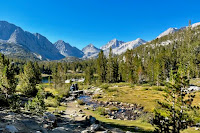In this episode (170) – 5 Years Later . . .
"Hey Google, turn on the kitchen lights."
Today's blog post illustrates how people take for granted the conveniences of modern everyday life and miss the satisfaction of wilderness camping. (Photos on YouTube).
"Labor Day weekend, will we find a campsite?"
And for the first time, we met a ranger checking wilderness permits. The trail was crowded with young folks exercising the last hurrahs of summer.
"We've already seen over 1,000 people on the trail this weekend."
Undaunted, we moved on. When we arrived at Gem Lakes, people were coming and going on the trail. We could reach the opposite side of the lake by scaling a rocky, narrow Ridgeline where few attempted to go. This would be our weekend home.
During this trip, I was hit with the stark reality of Wilderness camping that I had forgotten. For example, let's talk about training; months of walking, hiking with trekking poles, and strength training are essential to backpacking the Sierras.
However, that night I would soon realize the importance of a simple exercise one must do. Lay on your floor, sleep on the floor, and practice getting up from the floor; yes, situps - why? Unless you can sit up easily in a confined tent, it makes for tough sledding, especially as you age. Also, practice using your trekking poles - carry a fully loaded backpack - they are your lifeline for climbing, descending, balance, and safety.
Now, let's look at what you take for granted at home: water, food, and a toilet that flushes. Fresh drinking water means kneeling at the lake's edge, pumping a filter to keep you hydrated. And believe me, this becomes a challenge after hiking in the hot sun with no water left. I suggest having your filter handy, not buried at the bottom of your pack.
Pack a quickly prepared and accessible lunch - you'll be glad you did.
And, of course, the restroom. Sorry, this requires you to find a private location away from the water, dig a hole (with a stick), do your duty, and cover it well. Sounds like fun, huh? Just wait until you wake up in the middle of the night, with no moon, pitch dark, and staggering around with no choice but to crawl out of your tent and let nature take its course. There are no lights to turn on, no designated pit toilets, and in many cases, limited options (rocky terrain) - have fun!
Let me add just one more, breathing at over 10,000 ft. Be prepared to slow down, rest as needed, and be sure to pack Advil. Every effort will be a struggle until your body acclimates to the elevation.
Why go into all this detail? Mainly as a reminder to myself. And to remind those who think going wilderness camping means visiting REI and buying the latest gear or asking your smartphone;
"Hey, Siri, what do I need for wilderness camping?" Forget it.
Oh, there is no cell service, no Siri above 8,000 feet in the Sierras. You're on your own!
So, why elaborate on all this? There is redemption. One of my most memorable experiences during this adventure was beyond magical. I'm an early riser; up by 4:30 a.m., it's dark! Carefully using my headlamp, stumbling around camp, I lite the MSR WisperLite camp stove (on my knees), boil some water, make coffee, sit on a ridge next to the lake in the darkness, and admire the millions of stars twinkling like diamonds in the night sky.
If this is your first trip to the high elevation, my friends, you will catch your mouth open in awe, staring into space, stunned by the view. However, this campsite, at that moment in time, was remarkable, with no wind, on the north side of the crystal clear absolutely mirror lake.


Comments